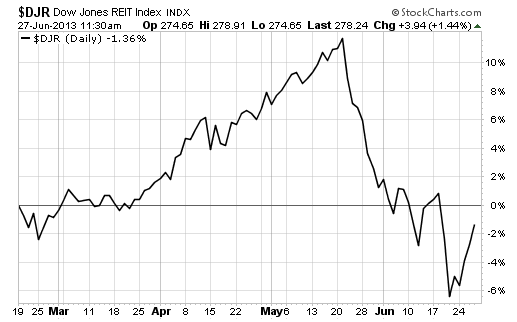Real Estate Investment Trusts (REITs) could soon turn from income investor darling to toxic portfolio sludge.
It’s already started…
While the S&P 500 fell a few percentage points over the past month, REITs tumbled over 12% – as measured by the Dow Jones REIT index (which covers over 90% of all publicly traded REITs):

Worst still, if you back out dividends (which have been substantial) REITs have underperformed the broad stock market since mid-2010.
Why the underperformance?
For the past 5+ years, REITs enjoyed the double-edged sword of Fed policy. Low borrowing costs (of essentially zero percent!) made it incredibly easy for these leveraged firms to borrow low and lend high.
But since rates can’t go LOWER than zero, there’s limited upside for REITs. Investors have kept one foot near the exit in anticipation of an inevitable rate hike when the Fed stopped, (or hinted at stopping as we recently witnessed) – because when rates rise, REITs will take it hard in the shorts.
First, profits will fall. That’s because the “spread” between what they can borrow for and what they can lend for will narrow. When you can borrow at zero percent and lend at 5%, you can leverage a billion dollar portfolio into hundreds of millions in profits.
But what happens if rates jump to just 1%? That shrinks their profitability by 1/5!
If rates rise high enough, current loan repayment levels won’t be high enough to secure new borrowing – and REITs won’t be able to secure a nickel of financing from anyone.
Companies like Annaly (NYSE :NLY), considered to be one of the biggest and best run REITs, could see their current 12.3% dividend drop from double digits to zero – and the stock will crater even further than it already has.
When your business model is based on periodically re-financing long term debt and pocketing the difference between borrowing costs and lending profits – you can expect huge gains when rates are super-low, like they are right now.
But every REIT investor should be intimately aware of the other side of the sword. When (not if!) rates rise, REITs will have a hard time.
We currently own two REITs in the High Yield Wealth portfolio – but we’re keeping a close eye on borrowing rates, and like every other REIT owner, we have one foot near the exit at all times.
We’ll let you know when things go from bad to worse for REITs.
 Facebook
Facebook
 Twitter
Twitter